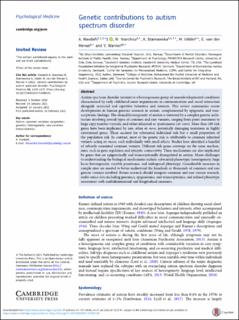| dc.description.abstract | Autism spectrum disorder (autism) is a heterogeneous group of neurodevelopmental conditions characterized by early childhood-onset impairments in communication and social interaction alongside restricted and repetitive behaviors and interests. This review summarizes recent developments in human genetics research in autism, complemented by epigenetic and transcriptomic findings. The clinical heterogeneity of autism is mirrored by a complex genetic architecture involving several types of common and rare variants, ranging from point mutations to large copy number variants, and either inherited or spontaneous (de novo). More than 100 risk genes have been implicated by rare, often de novo, potentially damaging mutations in highly constrained genes. These account for substantial individual risk but a small proportion of the population risk. In contrast, most of the genetic risk is attributable to common inherited variants acting en masse, each individually with small effects. Studies have identified a handful of robustly associated common variants. Different risk genes converge on the same mechanisms, such as gene regulation and synaptic connectivity. These mechanisms are also implicated by genes that are epigenetically and transcriptionally dysregulated in autism. Major challenges to understanding the biological mechanisms include substantial phenotypic heterogeneity, large locus heterogeneity, variable penetrance, and widespread pleiotropy. Considerable increases in sample sizes are needed to better understand the hundreds or thousands of common and rare genetic variants involved. Future research should integrate common and rare variant research, multi-omics data including genomics, epigenomics, and transcriptomics, and refined phenotype assessment with multidimensional and longitudinal measures. | |
